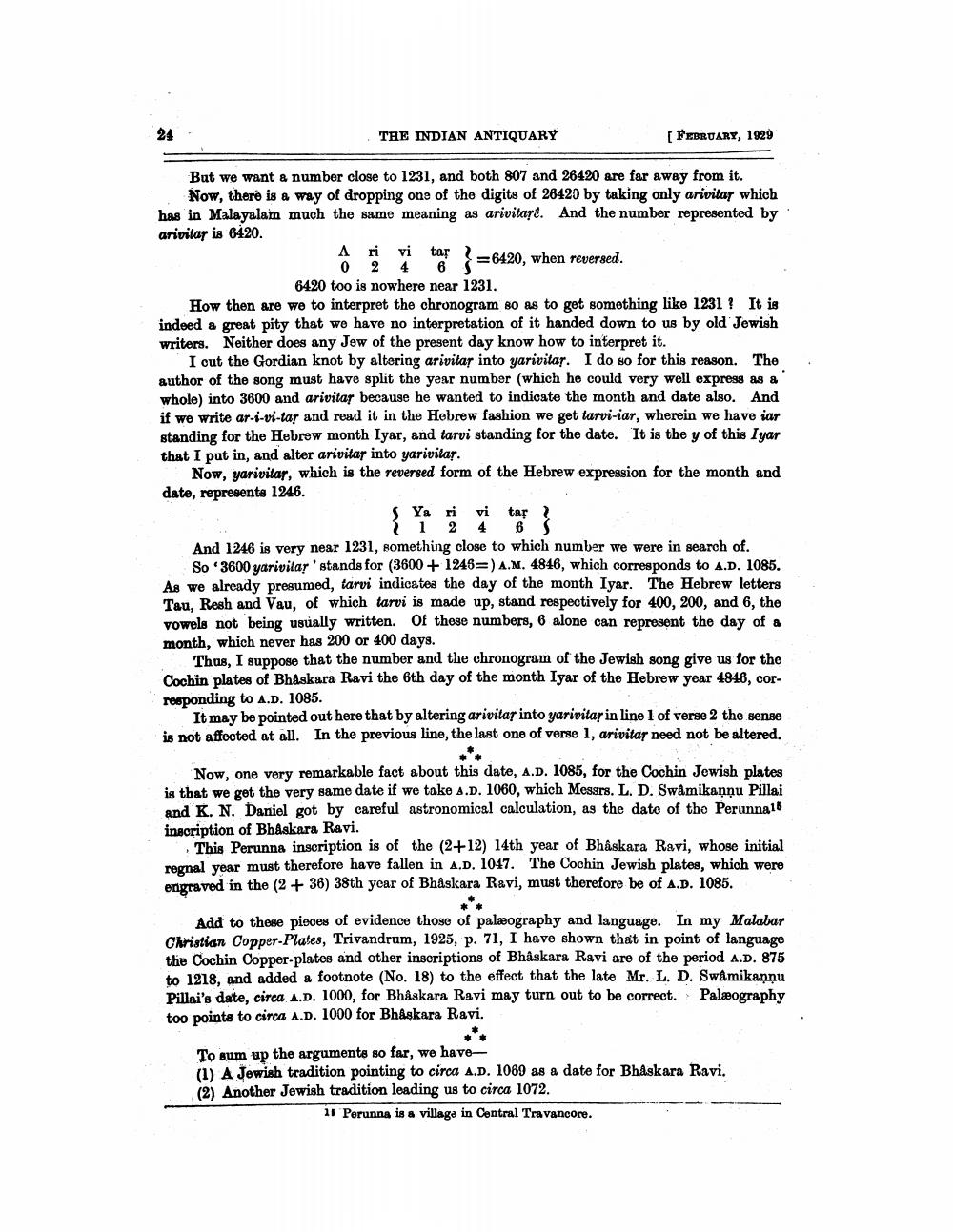________________
24
THE INDIAN ANTIQUARY
[ FEBRUARY, 1929
But we want a number close to 1231, and both 807 and 26420 are far away from it. Now, there is a way of dropping one of the digits of 26420 by taking only arivitar which has in Malayalam much the same meaning as arivitare. And the number represented by arivitar is 6420.
Ari vi tar }=6420, when reversed.
0 2 4
6420 too is nowhere near 1231.
How then are we to interpret the chronogram so as to get something like 1231? It is indeed a great pity that we have no interpretation of it handed down to us by old Jewish writers. Neither does any Jew of the present day know how to interpret it.
I cut the Gordian knot by altering arivitar into yarivitar. I do so for this reason. The author of the song must have split the year number (which he could very well express as a whole) into 3600 and arivitar because he wanted to indicate the month and date also. And if we write ar-i-vi-tar and read it in the Hebrew fashion we get tarvi-iar, wherein we have iar standing for the Hebrew month Iyar, and tarvi standing for the date. It is the y of this Iyar that I put in, and alter arivitar into yarivilar.
Now, yarivitar, which is the reversed form of the Hebrew expression for the month and date, represents 1246.
5 Ya ri vi 21 2 4 6 S
tar
And 1246 is very near 1231, something close to which number we were in search of.
So '3600 yarivilar' stands for (3600+ 1245) A.M. 4846, which corresponds to A.D. 1085. As we already presumed, tarvi indicates the day of the month Iyar. The Hebrew letters Tau, Resh and Vau, of which tarvi is made up, stand respectively for 400, 200, and 6, the vowels not being usually written. Of these numbers, 6 alone can represent the day of a month, which never has 200 or 400 days.
Thus, I suppose that the number and the chronogram of the Jewish song give us for the Cochin plates of Bhaskara Ravi the 6th day of the month Iyar of the Hebrew year 4846, corresponding to A.D. 1085.
It may be pointed out here that by altering arivitar into yarivitar in line 1 of verse 2 the sense is not affected at all. In the previous line, the last one of verse 1, arivitar need not be altered.
Now, one very remarkable fact about this date, A.D. 1085, for the Cochin Jewish plates is that we get the very same date if we take A.D. 1060, which Messrs. L. D. Swamikannu Pillai and K. N. Daniel got by careful astronomical calculation, as the date of the Perunna15 inscription of Bhaskara Ravi.
This Perunna inscription is of the (2+12) 14th year of Bhaskara Ravi, whose initial regnal year must therefore have fallen in A.D. 1047. The Cochin Jewish plates, which were engraved in the (2 + 36) 38th year of Bhaskara Ravi, must therefore be of A.D. 1085.
Add to these pieces of evidence those of palæography and language. In my Malabar Christian Copper-Plates, Trivandrum, 1925, p. 71, I have shown that in point of language the Cochin Copper-plates and other inscriptions of Bhaskara Ravi are of the period A.D. 875 to 1218, and added a footnote (No. 18) to the effect that the late Mr. L. D. Swâmikannu Pillai's date, circa A.D. 1000, for Bhaskara Ravi may turn out to be correct. too points to circa A.D. 1000 for Bhaskara Ravi.
Palæography
To sum up the arguments so far, we have
(1) A Jewish tradition pointing to circa A.D. 1069 as a date for Bhaskara Ravi. (2) Another Jewish tradition leading us to circa 1072.
15 Perunna is a village in Central Travancore.




